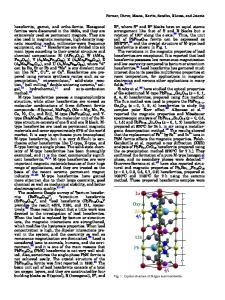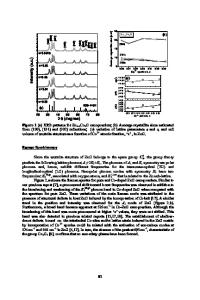Influence of rare-earth substitution on the structural, magnetic, optical and dielectric properties of ZnO nanoparticles
- PDF / 3,510,532 Bytes
- 8 Pages / 432 x 648 pts Page_size
- 99 Downloads / 448 Views
MRS Advances © 2019 Materials Research Society DOI: 10.1557/adv.2019.66
Influence of rare-earth substitution on the structural, magnetic, optical and dielectric properties of ZnO nanoparticles Ricardo Martínez1, Claudia Zuluaga1, Sandra Dussan2, Hannu Huhtinen3, Wojciech Jadwisienczak4 and Ratnakar Palai1 1
Department of Physics, University of Puerto Rico, Rio Piedras, San Juan, PR, 00931, USA
2
Department of Physical Sciences, University of Puerto Rico, Río Piedras, San Juan, PR, 00931-3323 USA
3 Wihuri Physical Laboratory, Department of Physics and Astronomy, University of Turku, Turku FIN20014, Finland
4 School of Electrical Engineering and Computer Science, Ohio University, Stocker Center, Athens, 45701, USA
Abstract
We report on structural, magnetic, optical, and dielectric properties of rare earth (Er and Yb)-doped ZnO nanoparticles with Na-co-doping for charge compensation by sol-gel process. The effect of doping concentration on the structural and dielectric properties of ZnO has been studied under magnetic field and UV excitation. The magnetodielectric and photodielectric effects at room temperature of doped ZnO are discussed in the light of magnetic and optical properties of Er3+ and Yb3+ ions.
INTRODUCTION: ZnO is one of the most promising candidates for semiconductors with wide range of applications in optoelectronic devices because its direct band gap (3.37 eV), high electron mobility (250 cm2/V.s), high thermal stability, and strong absorption of UV [1-5]. Due to its variable properties under external influences (e.g., magnetic field or
Downloaded from https://www.cambridge.org/core. Iowa State University Library, on 05 Feb 2019 at 20:11:18, subject to the Cambridge Core terms of use, available at https://www.cambridge.org/core/terms. https://doi.org/10.1557/adv.2019.66
UV light irradiation), ZnO is attractive to be a good matrix to host the excitations of rareearth (RE3+) ions (e.g., La, Ce, Pr, Eu, Gd, Ho, Er, Yb, etc.,) which by virtue of their electronic transitions, which can induce a spin polarization in ZnO and can unique affect its optical, electrical, and magnetic properties [6,7]. Trivalent rare earths (Er3+ and Yb3+) exhibit fascinating spectroscopic, luminescent, and magnetic properties [8,9]. REs also have higher magnetic moment (Er3+ = 9.6B and Yb3+= 4.5B) than transition metals. The doping of ZnO with RE3+ elements can to tune its optical, electrical and magnetic properties [10] which can be influenced by the unique electronic structure that the RE3+ have [11]. Thereupon, the motivation and importance to work with RE 3+ doped ZnO materials is based on the co-existance of semiconducting, electrochemical and optical properties. Since the ionic radii of Zn 2+ ion is very small compared with RE3+ ions, the incorporation of trivalent RE3+ ions in ZnO makes distortions in the ZnO matrix, which leads to asymmetricity in the electronic environment of the system [12]. To date, the improvement of magnetic and optical properties of ZnO via doping has been reported by several resear
Data Loading...











